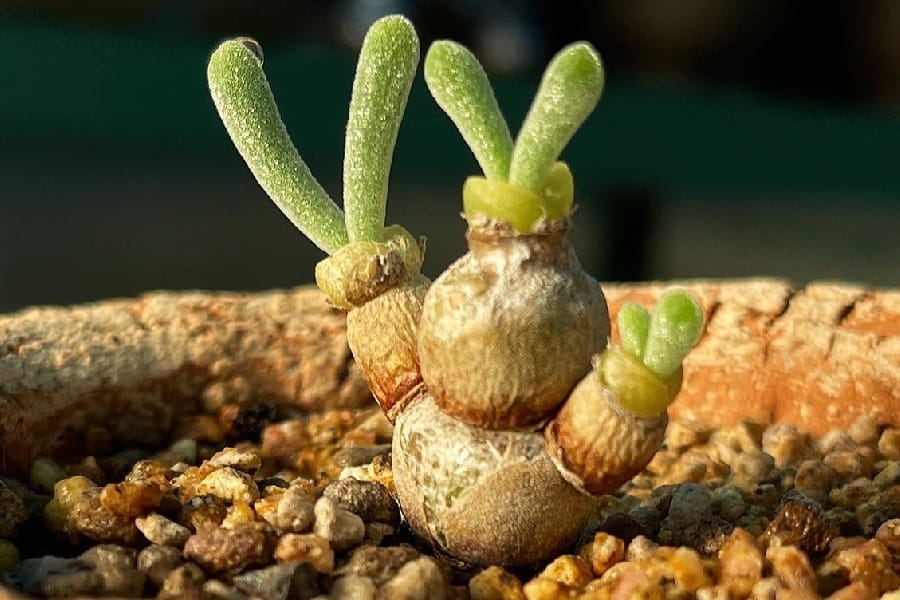Monilaria obconica: Characteristics and Care
Have you ever come across a plant that looks like a bunch of cute bunny ears? If not, let us introduce you to Monilaria obconica, the most adorable succulent you’ll ever lay your eyes on! This little green wonder is going to captivate you with its unique charm and leave you wondering if nature is playing a trick or if it’s an evolutionary masterpiece.

Contents
About Monilaria obconica
Native to the Namaqualand region of South Africa, Monilaria obconica belongs to the Aizoaceae family and the Monilaria genus. It’s fondly called the Bunny-Ear Succulent, Bunny-Ear Pearlfig, or simply the Bunny Succulent, thanks to its bunny-like appearance. This seasonal deciduous plant grows in clusters on mountains, making it a sight to behold.
What sets Monilaria obconica apart is its ability to grow two different types of leaves, a characteristic of heterophyllous plants. The first set of leaves forms at the top of the roots in a tight cluster, each leaf measuring around 0.5 inches in diameter. As the plant grows, it develops a second set of longer, thinner leaves ranging from 4-6 inches in length and 0.15 inches in diameter. This contrast between the two leaf formations creates the illusion of a bunch of bunny heads with long ears, making it an absolute showstopper!
But that’s not all! Monilaria obconica’s leaves are covered in tiny crystalline cells on the epidermal layer, giving them a shiny, pearl-like appearance and a fuzzy, furry look. These cells help the plant conserve moisture for weeks, even in arid environments, making it a true desert survivor.
Although tiny, reaching only 6-8 inches in height, Monilaria obconica packs a punch with its vibrant colors. The green leaves turn a stunning red hue when exposed to sunlight, and the plant produces beautiful rose-colored or white flowers in spring, each measuring around 0.7 inches in diameter.
Monilaria obconica Care Guide
Light
This succulent craves plenty of sunlight, ideally 6-8 hours of direct light per day. If you can’t provide natural light, consider investing in a grow light to ensure your bunny-eared friend thrives.

Water
While Monilaria obconica is a succulent, it has slightly different watering needs than most. During the spring and fall growth periods, water it thoroughly every 5 days. In summer, reduce watering to once every 5 days, and in winter, water every 10 days. This plant doesn’t like extended droughts, so keep an eye on the soil moisture.
Soil
Like most succulents, Monilaria obconica prefers well-draining soil. Mix loam-based compost with materials like horticultural grit or perlite to ensure proper drainage and root growth. Choose a small pot, as this plant blooms better when slightly root-bound.
Fertilizer
During the growing seasons, you can feed your Monilaria obconica with a balanced, diluted fertilizer. Avoid fertilizing in extreme temperatures (below 41°F or above 95°F).
Temperature and Humidity
Monilaria obconica falls under USDA Hardiness Zones 10a to 11b. This succulent thrives in temperatures between 59-77°F. Avoid exposing it to temperatures above 95°F, as it may go dormant, or below 41°F, which can cause frostbite. While it can tolerate some humidity, it’s best to provide a warm, dry environment to prevent issues like rot or pests.

Pests and Problems
The most common issue with Monilaria obconica is leaf drop, often caused by insufficient sunlight, overwatering, or over-fertilizing. Keep an eye out for pests and provide the right care to prevent leaf loss.
Pruning
Pruning isn’t necessary for this plant, but you can remove any damaged or discolored leaves to maintain its appearance.
Potting and Repotting
Monilaria obconica prefers infrequent repotting and can happily stay in the same pot for many years. Frequent repotting can actually lead to poor flowering.
When it comes to pot size, this succulent does best in small, individual pots that provide a slightly root-bound environment. Larger containers often result in relatively poor bloom quality.
Only repot into a slightly larger pot when necessary, using a well-draining succulent soil mix. The right pot size, along with minimal disturbance, encourages better flowering and allows this adorable plant to thrive.
Bunny Succulent Propagation Methods
Monilaria obconica can be propagated through seeds or stem cuttings, allowing you to multiply your bunny-eared beauties with ease.
Seeds:
- Obtain fresh seeds from a reliable source.
- Fill a well-draining container with a suitable succulent/cactus soil mix.
- Sow the seeds on the soil surface, spacing them apart for proper growth.
- Cover the seeds with a thin layer of soil, no more than their diameter.
- Gently water the soil, being careful not to displace the seeds.
- Place the container in a warm, bright location, and keep the soil moist but not waterlogged.
- Once the seeds germinate and seedlings appear, gradually expose them to more sunlight.
- When the seedlings are strong enough, transplant them into individual pots.
Stem cuttings:
- Take cuttings from a healthy plant, ensuring each cutting has two branches.
- Allow the cuttings to dry for a day or two before planting.
- Plant the cuttings in a well-draining soil mix and keep them in shade.
- Water every two days once the soil is dry, and you’ll soon see new roots sprouting.
- Once established, gradually introduce the new plants to sunlight.
With both methods, you can quickly build an impressive collection of these irresistible succulents. Imagine having multiple pots filled with clusters of bunny ears in various shades of green and red – it’s a plant lover’s dream come true!
